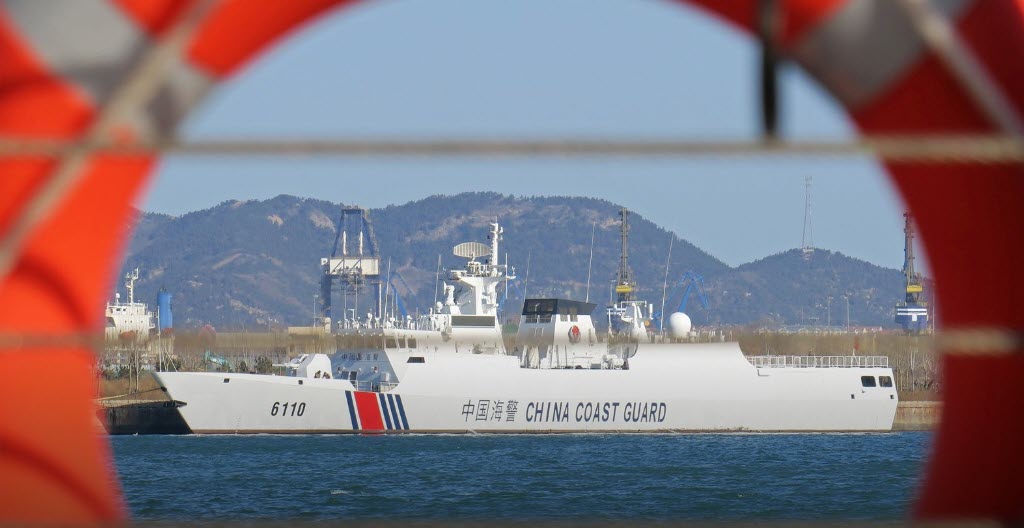China Increasingly Aggressive Toward Its Neighbors — and the U.S.
Mar 29 2024China has shown escalating belligerence in its surroundings seas, confident that it has no rivals in strength among what it calls the "small countries" such as Indonesia, Vietnam, the Philippines. It has built up reefs and outcroppings in the South China Sea into military bases from which it can force those nations off the fishing grounds that they rely on to feed their populations.
These invasions are in violation of the 1982 United Nations Convention on the Law of the Sea to which 168 countries are signatories that prescribes for each coastal nation an "economic zone" extending 200 nautical miles from its shores for its exclusive use. But China sweeps aside Western-inspired precepts of national sovereignty that conflict with its intended global dominance where it will set the rules. And so, on a boat sailing out of the Philippines at night near Mischief Reef, militarized by China in an area of the South China Sea that an international tribunal has said belongs to the Philippines, a New York Times reporter said that cell phones on board pinged with the message "Welcome to China", notwithstanding that they were 900 miles from the nearest China landfall. They were not in fact welcome and were assaulted with sound that shook their bodies, blinding searchlights, and threats of ramming.
years of harassmentIn April of 2020, Vietnam accused a Chinese patrol ship of ramming and sinking a Vietnamese fishing boat near the Paracel islands in the South China Sea, leaving 22 survivors in the water for hours clinging to the wreckage. That June, another was rammed in the same zone by a Chinese ship. During the same period a Malaysian drillship was harassed near Borneo. American and Australian warships came to its relief.
Harassing and violence has been the norm ever since. Beijing has adopted a policy that treats the economic zones of other nations as its own, 
Philippine boat blasted with Chinese water cannon.
that feeding its own people at cost to those nations is the new rule. Chinese boats fish in Indonesian waters. To drive off Philippine boats and deprive them of their catch, swarms of Chinese fishing vessels band together as "maritime militias". This past October, a Chinese coast guard ship collided with a Philippine boat that was trying to re-supply military personnel on the Second Thomas Shoal in the Spratly Islands. The ramming followed bombardment with a military-grade laser and a water cannon.
To escort fishing vessels, China has floated a vast armada of boats bigger than U.S. Navy destroyers with 76-millimeter cannons mounted on deck and equipped for anti-ship missiles — but they are painted white, with “China Coast Guard” on their hulls.
The coast guard has become an alternate navy, part of China’s objective of becoming a “maritime great power”. China sees its growing coast 
guard fleet as instrumental in controlling near sea waterways for fishing and mining, able to use force but without triggering a response from its flummoxed neighbors that an attack by a military ship would. A year ago, a coast guard squadron circled for over 80 hours the eight, small, uninhabited Senkaku Islands in the East China Sea, islands long contested between Japan and China. China’s threat signals its intention to force its claim and militarize these eastward outposts just as they’ve done with the atolls in the South China Sea.
China has made clear that it intends to resolve sovereignty disputes in its near seas — the Yellow, East China, and South China Seas — on its own terms
confronting the U.S.The U.S. has for decades acted to enforce the freedom of navigation of the world’s oceans establish by traversing global waterways with its ships and military aircraft. China has notoriously ignored the 1982 Law of the Sea protocols by claiming its nearby seas as its own and challenging interlopers.
The Pentagon reported a “sharp increase in coercive” behavior in the East and South China Seas. The Pentagon cited 180 dangerous incidents since autumn 2021—“more in the past two years than in the decade before that.” One PLA jet fighter harassed an American aircraft for more than 15 minutes, “clearly armed and closing to just 30 feet away.” Last year, a Chinese naval ship sailed within 150 yards of a U.S. missile destroyer plying the Taiwan Strait. Last October, the crew of a U.S. Air Force B-52 said a Chinese fighter jet risked a collision when it flew with “uncontrolled excessive speed" within 10 feet of the giant bomber over the South China Sea in a nighttime maneuver.
A video showed what the U.S. called an “unsafe” Chinese maneuver in the Taiwan Strait last June, when a Chinese navy ship cut sharply across the path of an American destroyer, forcing the U.S. ship to slow to avoid a collision.
Last May, a Chinese fighter jet came within 400 yards of a U.S. reconnaissance plane flying in international air space above the South China Sea. The unprofessional intercept forced the U.S. plane to fly through the jet’s wake and was a clear attempt to intimidate.
The list is longer but these are representative of increasing provocative actions Xi has greenlighted. Any one of them might ignite an incident that could escalate into war.
Please subscribe if you haven't, or post a comment below about this article, or
click here to go to our front page.

